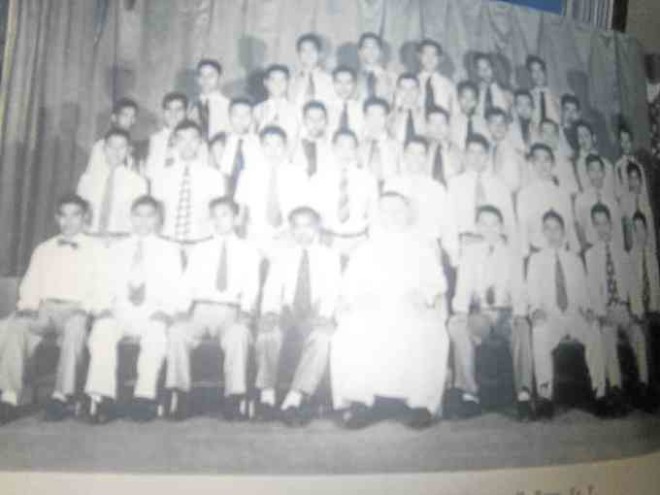
Grade school at Ateneo de Manila was spent in Padre Faura, Ermita, Manila, where the buildings were still scarred by the war which had ended only a few years ago.
Then the school transferred to its present location, Loyola Heights in Quezon City, amid rolling hills overlooking the Marikina Valley. There was a forest nearby, now probably gone. Mountains provided an impressive background to the college building at one end of the campus.
The gymnasium with its gigantic Blue Eagle was already an iconic landmark then, and there was much activity in the Covered Courts. There were spanking new buildings in the High School grounds, and during rain showers the campus took on a new look and appeared to bloom with greenery.
The rector was the very handsome Fr. James McMahon, and all the Assumption and Maryknoll colegialas had a crush on him. The required holy terror was personified by Dean of Studies Fr. Raymond Gough, whom we called Caligula because he spoke like Peter Ustinov, who played the mad Roman emperor in the MGM film “Quo Vadis,” starring Robert Taylor and Deborah Kerr and was all about the early Christians being fed to the lions.
Fr. Joseph Galdon we called “Bob Hope” because of his supposed resemblance to the American comic. Our class director was the jovial Fr. Paul Campbell.
Bias against the nearby University of the Philippines-Diliman was strong (and vice-versa). I remember one teacher saying, “How can you call that UP professor a good man when he is an atheist?” But the image of a godless institution was softened somehow when Father Gough celebrated Mass there and good-naturedly complained, “There were so many receiving Holy Communion my back was breaking. . .”
Irish-American Jesuits in their white soutanas were all over the place. There was only one Spanish Jesuit, Father Orozco, and he taught us Latin.
Most of the school officials and teachers of that era are gone now, but dear “Mr. Pagsi” (Onofre Pagsanghan) is still around, teaching. He taught us Religion and English, and had not yet founded Dulaang Sibol, which would make him famous.
And there was Eric Torres, the poet-art critic. He was the only teacher we called by his first name after school. “I’m in a reunion mood,” he told my classmate-cousin Dando Santillan and me when we bumped into him once at Rockwell Center.
And there was classmate Rolly Severino, who once pawed an effeminate schoolmate, declaring “This is my wife…,” unaware that an American Jesuit without a sense of humor was right behind him. Before we knew it the intercom in every class was intoning, “Rolando Severino of 4-D is hereby suspended…”
Classmate Mike Ligon (later a sportswriter for the old Manila Times) had an argument with Father Campbell, lost his temper, rose and shouted, “This is a democracy!” Father Campbell thundered in reply, “The Ateneo is not a democracy!” Everybody froze.
There were penalties for speaking in Tagalog. The only time we could speak in the language was during the Tagalog hour when we grappled with the verses of Balagtas’ “Florante at Laura”—with English translation in the opposite pages!
From those formative years, when Ateneo was an all-male college, I developed a lifelong devotion to the Lord Jesus and Mother Mary, liberal and unconventional Catholic that I may be, and to the Spanish founder of the Society of Jesus, St. Ignatius of Loyola, and I pray to him in his own language.
Another legacy is the English language which has served me well, plus a love of English literature.
In old age, memory can be a tricky process, and in my case highly selective. By and large, those years at Ateneo of olden days were a happy experience with only a few sad moments. The song of Barbra Streisand said it all: “Memories can be beautiful and yet if too painful to remember we simply choose to forget. So it’s the laughter we will remember, whenever we remember the way we were…” —CONTRIBUTED